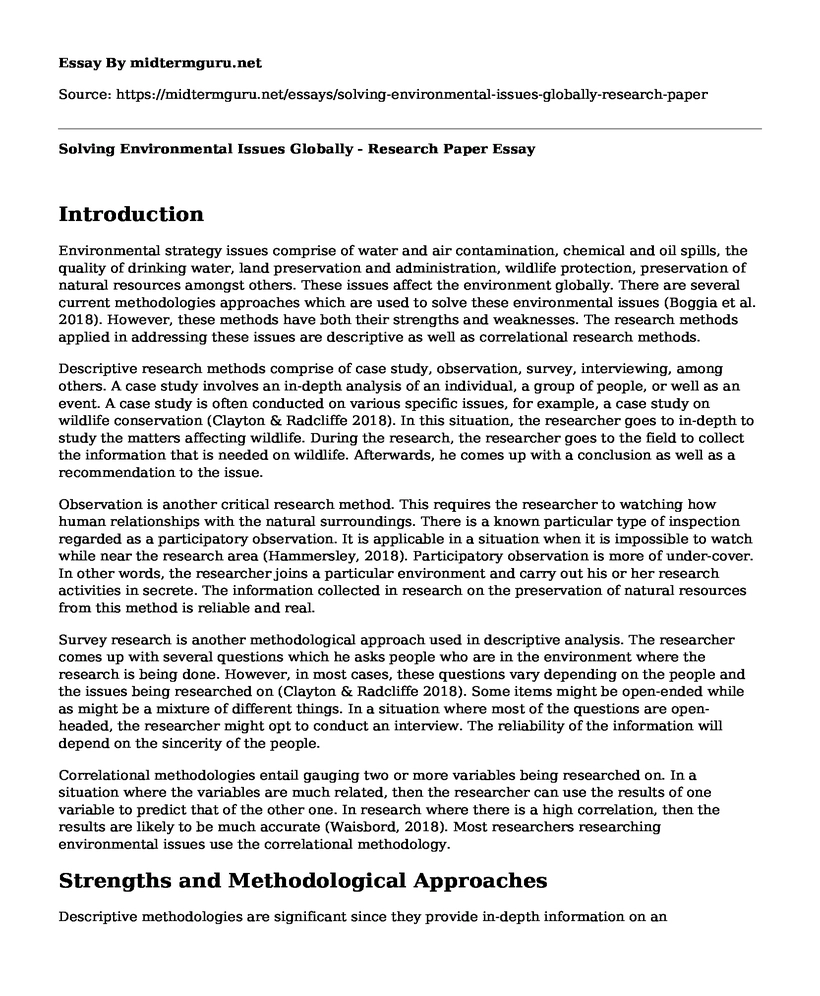Introduction
Environmental strategy issues comprise of water and air contamination, chemical and oil spills, the quality of drinking water, land preservation and administration, wildlife protection, preservation of natural resources amongst others. These issues affect the environment globally. There are several current methodologies approaches which are used to solve these environmental issues (Boggia et al. 2018). However, these methods have both their strengths and weaknesses. The research methods applied in addressing these issues are descriptive as well as correlational research methods.
Descriptive research methods comprise of case study, observation, survey, interviewing, among others. A case study involves an in-depth analysis of an individual, a group of people, or well as an event. A case study is often conducted on various specific issues, for example, a case study on wildlife conservation (Clayton & Radcliffe 2018). In this situation, the researcher goes to in-depth to study the matters affecting wildlife. During the research, the researcher goes to the field to collect the information that is needed on wildlife. Afterwards, he comes up with a conclusion as well as a recommendation to the issue.
Observation is another critical research method. This requires the researcher to watching how human relationships with the natural surroundings. There is a known particular type of inspection regarded as a participatory observation. It is applicable in a situation when it is impossible to watch while near the research area (Hammersley, 2018). Participatory observation is more of under-cover. In other words, the researcher joins a particular environment and carry out his or her research activities in secrete. The information collected in research on the preservation of natural resources from this method is reliable and real.
Survey research is another methodological approach used in descriptive analysis. The researcher comes up with several questions which he asks people who are in the environment where the research is being done. However, in most cases, these questions vary depending on the people and the issues being researched on (Clayton & Radcliffe 2018). Some items might be open-ended while as might be a mixture of different things. In a situation where most of the questions are open-headed, the researcher might opt to conduct an interview. The reliability of the information will depend on the sincerity of the people.
Correlational methodologies entail gauging two or more variables being researched on. In a situation where the variables are much related, then the researcher can use the results of one variable to predict that of the other one. In research where there is a high correlation, then the results are likely to be much accurate (Waisbord, 2018). Most researchers researching environmental issues use the correlational methodology.
Strengths and Methodological Approaches
Descriptive methodologies are significant since they provide in-depth information on an environmental issue. Interestingly, we get substantial details that we were not even looking for. Observation, in particular, allows the researcher to see the appearance of things in their natural environment (Boggia et al. 2018). On the other hand, correlational methodologies provide a complicated relationship between various variables. Moreover, it promotes predictions from the information collected; hence, a lot of time is not wasted.
Weaknesses of Methodological Approaches
Descriptive methodological approaches have some shortcomings. Firstly, we can't determine the cause of a behavior. Secondly, the information might not be reliable since some people and animals change their character once they realize that someone is observing them. There is also time wastage; hence, the methodologies are expensive. More so, observation methodology is only applicable to people who can see (Rassini, 2019). In correlational methods, the information might be unreliable since the technique concentrates on comparing different variables.
The most effective methodology to be used researching the causes of destruction of natural resources of observation approach. Participatory observation should be used in specific. The method is appropriate since the researcher will get the information on the topic in deep. When it comes to the providence of recommendation, the researcher will give useful and realistic information. The advice given will help solve the problem of destruction of natural resources; hence, the observation method is the best method to be used.
References
Boggia, A., Massei, G., Pace, E., Rocchi, L., Paolotti, L., & Attard, M. (2018). Spatial multicriteria analysis for sustainability assessment: A new model for decision making. Land use policy, 71, 281-292.
Clayton, T., & Radcliffe, N. (2018). Sustainability: a systems approach. Routledge.
Hammersley, M. (2018). Routledge Revivals: What's Wrong With Ethnography? (1992): Methodological Explorations. Routledge.
Rossini, F. (2019). Integrated impact assessment. Routledge.
Waisbord, S. (2018). Family tree of theories, methodologies, and strategies in development communication. Handbook of Communication for Development and Social Change, 1-40.
Cite this page
Solving Environmental Issues Globally - Research Paper. (2023, Feb 02). Retrieved from https://midtermguru.com/essays/solving-environmental-issues-globally-research-paper
If you are the original author of this essay and no longer wish to have it published on the midtermguru.com website, please click below to request its removal:
- Paper Example on Lifestyle Practices That Pose a Risk to a Person's Wellbeing
- Ethical Beliefs on Climate Change as Observed by Christians and Muslims - Paper Example
- Are Chimpanzees 'Persons'? - Essay Sample
- Essay Sample on Hurricane Katrina
- Fossil Fuels: Driving Engines & Environmental Pollution - Research Paper
- The Perils of Plastics: How Our Everyday Habits Impact Our World - Research Paper
- Boeing's Grounding: A Deadly Blow to Business - Essay Sample







